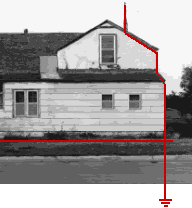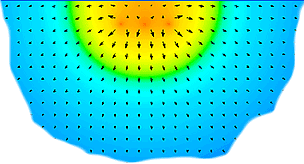Earth grounding resistance*

The power ground is often bonded to the house's incoming pipework, and pipes and cables entering the bathroom. The power grounding is used to protect from electric shock hazard. Grounding is often used to conduct lightning strikes harmlessly to earth rather than starting fires and damaging equipment This illustrates that an electrical ground should have an appropriate current-carrying capability in order to serve as an adequate zero-voltage reference level.
Grounding consist of metal bodies (tubes, rods) buried in the ground. To calculate the grounding resistance the DC conduction module of QuickField can be used.

To simulate current distribution around grounding you should specify voltage and current sources, earth resistivity. The calculation area is restricted by the air above and by artificial boundary at other sides. It is assumed that far from the grounding the potential is zero. You should place the artificial boundary far away from the grounding point to avoid miscalculations.
- Ground connector simulation (with video instruction).
- 3-phase transmission line with grounding (simulation example)